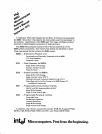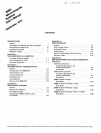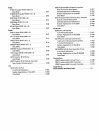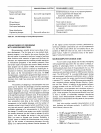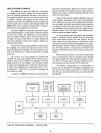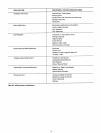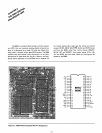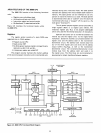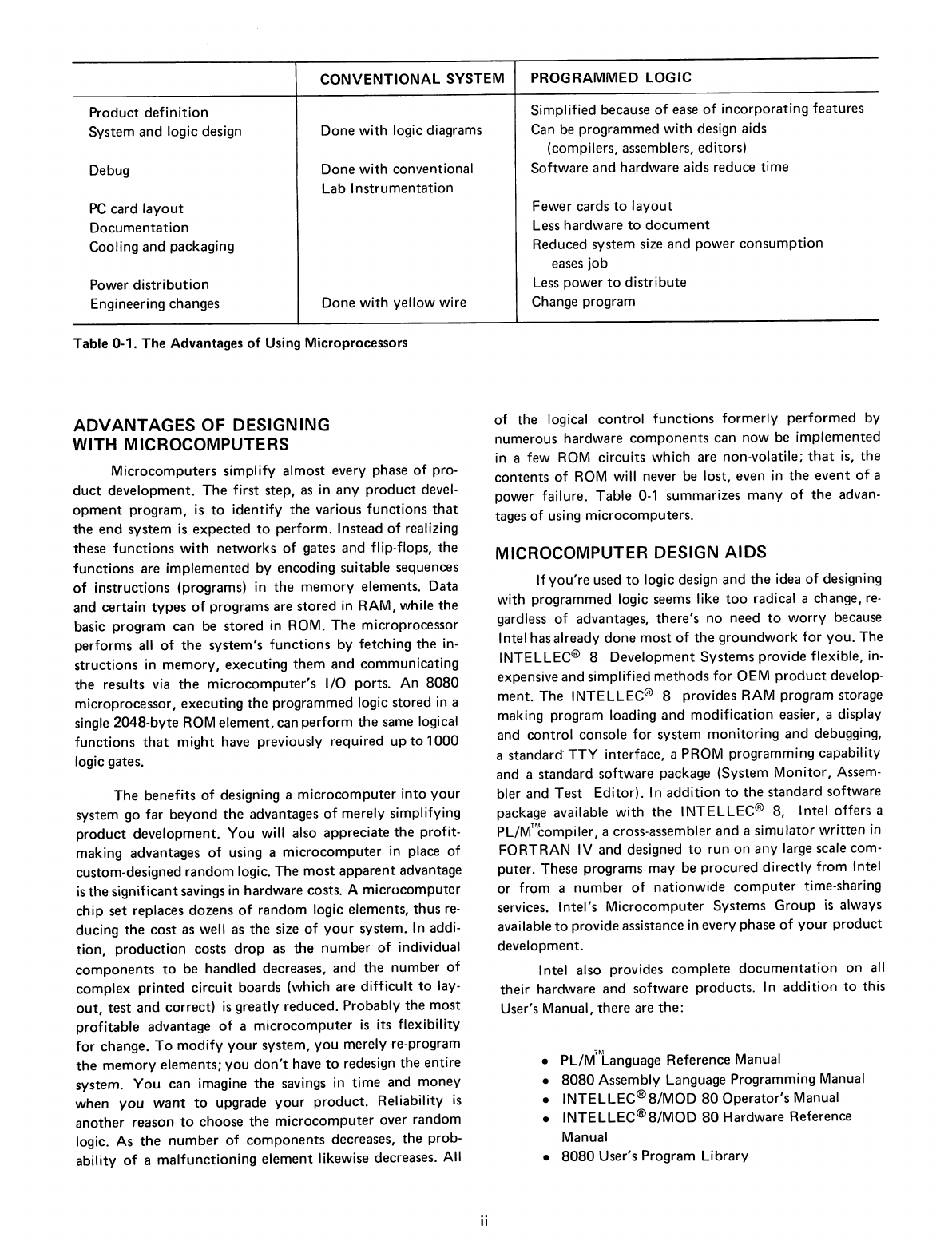
Product
definition
System
and
logic design
Debug
PC
card
layout
Documentation
Cooling
and
packaging
Power
distribution
Engineering
changes
CONVENTIONAL
SYSTEM
Done
with
logic diagrams
Done
with
conventional
Lab
Instrumentation
Done
with
yellow
wire
PROGRAMMED LOGIC
Simplified
because
of
ease
of
incorporating
features
Can be
programmed
with
design aids
(compilers, assemblers,
editors)
Software
and
hardware
aids
reduce
time
Fewer cards
to
layout
Less
hardware
to
document
Reduced
system
size
and
power
consumption
eases
job
Less
power
to
distribute
Change
program
Table 0-1. The Advantages
of
Using Microprocessors
ADVANTAGES
OF DESIGNING
WITH MICROCOMPUTERS
Microcomputers
simplify
almost
every
phase
of
pro-
duct
development.
The
first
step,
as in
any
product
devel-
opment
program,
is
to
identify
the
various
functions
that
the
end
system
is
expected
to
perform.
Instead
of
realizing
these
functions
with
networks
of
gates
and
flip-flops,
the
functions
are
implemented
by
encoding
suitable
sequences
of
instructions
(programs)
in
the
memory
elements.
Data
and
certain
types
of
programs
are
stored
in RAM, while
the
basic
program
can
be
stored
in ROM.
The
microprocessor
performs
all
of
the
system's
functions
by
fetching
the
in-
structions
in
memory,
executing
them
and
communicating
the
results via
the
microcomputer's
I/O
ports.
An
8080
microprocessor,
executing
the
programmed
logic
stored
in
a
single
2048-byte
ROM
element,
can
perform
the
same logical
functions
that
might
have previously
required
up
to
1000
logic gates.
The
benefits
of
designing a
microcomputer
into
your
system
go
far
beyond
the
advantages
of
merely
simplifying
product
development.
You
will also
appreciate
the
profit-
making
advantages
of
using a
microcomputer
in place
of
custom-designed
random
logic.
The
most
apparent
advantage
is
the
significant
savings in
hardware
costs. A
microcomputer
chip
set
replaces
dozens
of
random
logic
elements,
thus
re-
ducing
the
cost
as well as
the
size
of
your
system.
In addi-
tion,
production
costs
drop
as
the
number
of
individual
components
to
be
handled
decreases,
and
the
number
of
complex
printed
circuit
boards
(which
are
difficult
to
lay-
out,
test
and
correct)
is
greatly
reduced.
Probably
the
most
profitable
advantage
of
a
microcomputer
is
its flexibility
for
change.
To
modify
your
system,
you
merely
re-program
the
memory
elements;
you
don't
have
to
redesign
the
entire
system.
You
can
imagine
the
savings in
time
and
money
when
you
want
to
upgrade
your
product.
Reliability
is
another
reason
to
choose
the
microcomputer
over
random
logic. As
the
number
of
components
decreases,
the
prob-
ability
of
a
malfunctioning
element
likewise decreases. All
ii
of
the
logical
control
functions
formerly
performed
by
numerous
hardware
components
can
now
be
implemented
in
a few ROM
circuits
which
are
non-volatile;
that
is,
the
contents
of
ROM will never be lost, even in
the
event
of
a
power
failure.
Table
0-1
summarizes
many
of
the
advan-
tages
of
using
microcomputers.
MICROCOMPUTER DESIGN
AIDS
If
you're
used
to
logic design
and
the
idea
of
designing
with
programmed
logic seems like
too
radical a change,
re-
gardless
of
advantages,
there's
no
need
to
worry
because
Intel has
already
done
most
of
the
groundwork
for
you.
The
INTELLEC® 8
Development
Systems
provide
flexible, in-
expensive
and
simplified
methods
for
OEM
product
develop-
ment.
The
INT~LLEC@
8
provides
RAM
program
storage
making
program
loading
and
modification
easier, a display
and
control
console
for
system
monitoring
and
debugging,
a
standard
TTY
interface,
a PROM
programming
capability
and
a
standard
software
package
(System
Monitor,
Assem-
bler
and
Test
Editor).
In
addition
to
the
standard
software
package available
with
the
INTELLEC® 8, Intel offers a
PL/MTcompiler, a cross-assembler
and
a
simulator
written
in
FORTRAN
IV
and
designed
to
run
on
any
large scale com-
puter.
These
programs
may
be
procured
directly
from Intel
or
from
a
number
of
nationwide
computer
time-sharing
services.
Intel's
Microcomputer
Systems
Group
is
always
available
to
provide
assistance in
every
phase
of
your
product
development.
Intel also provides
complete
documentation
on
all
their
hardware
and
software
products.
In
addition
to
this
User's Manual,
there
are
the:
•
PL/M'~Language
Reference
Manual
•
8080
Assembly
Language
Programming
Manual
•
INTELLEC®8/MOD
80
Operator's
Manual
•
INTELLEC®8/MOD
80
Hardware
Reference
Manual
•
8080
User's
Program
Library




